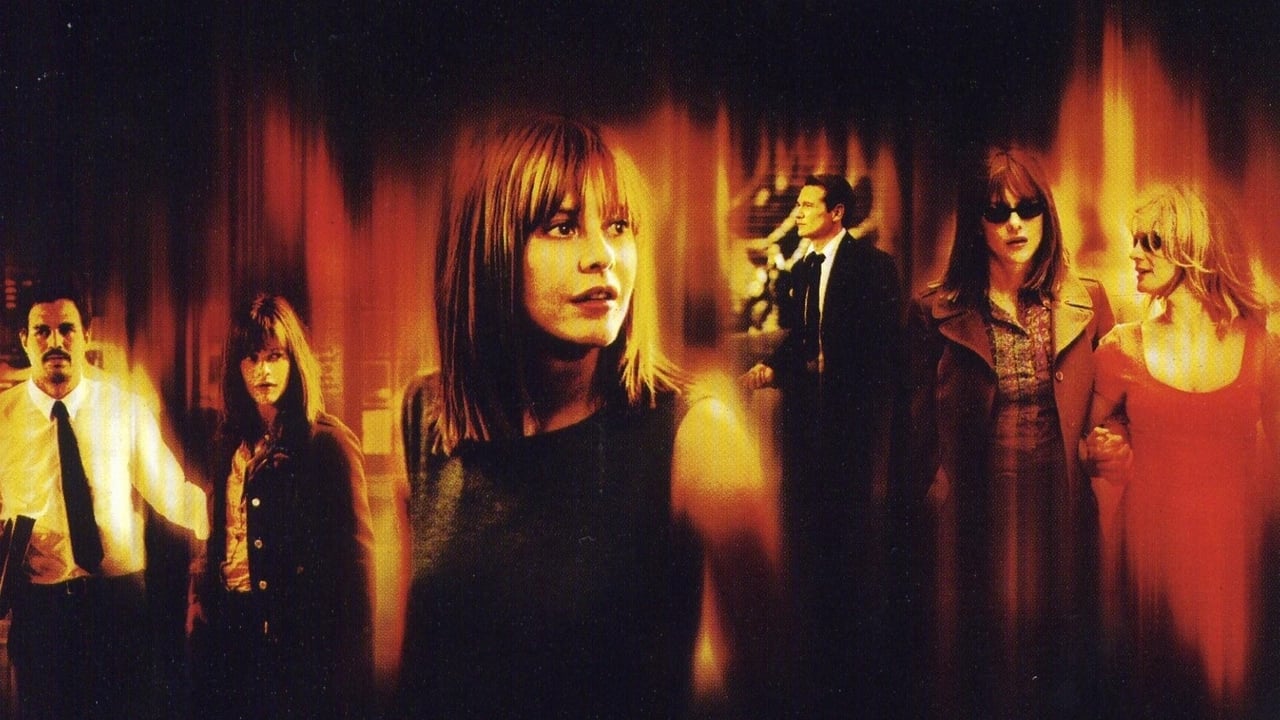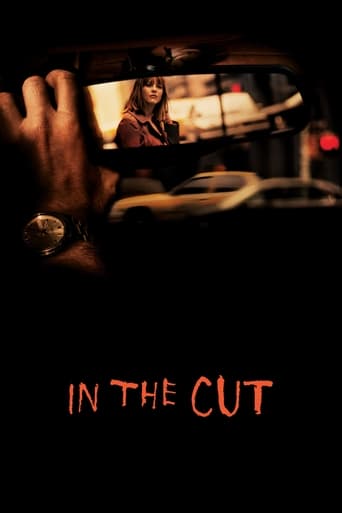

This is my first review on IMDb and I've chosen In the Cut because I think it's simply the most underrated film ever made. The perspicacious manner in which the characters subtly squirm into their respective roles is scintillating. This film is sexy and its dark and quintessentially so. I love Mark Ruffalo, he's almost seedy to the point of criminality yet is able to encapsulate a determined sexual energy that he superimposes upon the frigidity of Meg Ryan - who is gorgeous in this, if nothing else she's real and vulnerable, a great performance. Don't expect this film to create the perfect theatrical arc, it won't. Allow the atmosphere of unsettling mystery and damaged persona into your thinking and this becomes a dark portrayal of sexual frustration, licentiousness and fear. It's all about the frailty of the human condition. This is Campion at her best.
... View More"Men love death. In everything they make, they hollow out a central place for death, let its rancid smell contaminate every dimension of whatever still survives. Men especially love murder. In art they celebrate it, and in life they commit it. They embrace murder as if life without it would be devoid of passion, meaning, and action, as if murder were solace." - Andrea Dworkin Jane Campion's "In the Cut" stars Meg Ryan as Frannie, a frumpy English teacher who believes that "all slang masks sex" and "all language masks violence". Having grown calloused after a long line of failed relationships, Frannie spends the film's first act seemingly drawn to death and perhaps her own demise."Cut" then turns into a sordid fairy tale, Frannie stepping into a darkened basement in which she sees a serial killer receiving oral sex from a woman who will later be murdered. From here on the film uses a familiar thriller narrative as a springboard for themes which have interested Campion throughout her career. And so the film portrays a world of hyper-masculine aggression, confused female psyches - where eroticism and masochism seem to occupy the same befuddled head-space - and an overwhelming sense of all-pervasive violence directed toward women. The film's title refers both to police/crime slang (a secluded, hidden location), and a euphemism for the vagina.Because a spate of murders have been committed in her neighbourhood, Frannie quickly finds herself in the company of Detective Malloy (Mark Ruffalo). They begin to develop a relationship. Though she suspects that Malloy might be a serial killer, Frannie remains attracted to him. Years of jaded isolation are overwhelmed by yearnings for danger, passion and empowerment, which Malloy seems to supply. Frannie doesn't necessarily love Malloy; she enjoys the violence he leaks into her life.The film's later portions (which include deliberately kitschy flashbacks) play like a meditation on the romantic myths underlying societies, and the unexamined misogyny of slasher/horror films. But the film goes beyond the shattering of idealised love, romantic illusions and the conditioned expectations of women (which nobody really believes today, whilst simultaneously acting as though they wholeheartedly do), and seems to instead portray the "woman's" desire to claim for herself a part of the world's "masculinist violence". This is best epitomised by a scene in which a murder-suspect takes Frannie into the woods, a place where she would traditionally be executed but is instead trained to use a gun.Familiar notions of femininity, beauty and romance are undercut throughout the film: the men are barbarous oafs (the film's serial killer is fuelled by castration anxieties), the woman are grimy and unglamourous, all the film's relationships are rooted in violence (even when at their most tender or heartfelt), death permeates everything, it seems impossible to discern between freedom and slavery, law and crime, and all Campion's women are potential corpses whilst all men may be killers at worse, racist/foul/sexist/promiscuous at best. The film itself seems to exist in a surreal dream-space of shadowy, sleazy sets (many phallic shapes, lighthouses etc) where poetry (corresponding to the feelings of characters) litter walls and strippers seem to forever live behind the woodwork. Objects familiar in courtship fantasies (flowers, hearts, wedding rings, ice rings, baby carriages, bracelets), traditionally romantic situations and/or locales, as well as objects typically linked to female domesticity (washing-machines, here stuffed with corpses) are likewise scuffed up.Nevertheless, the film isn't all pessimistic. Malloy may be the antithesis of chivalry and romance (the root of the word "romance" is itself "idealised" or "non existent"), but he is honest, caring and tender with Frannie (his sex acts with her stress his subordination to her needs), and there is warmth in the unglamourous but tender way in which he bathes her. It also becomes increasingly clear that Frannie is incredibly messed up, and that the "aesthetic" of the film is perhaps an articulation of her own warped, damaged world view. It isn't that there isn't incredible violence always bearing down on Frannie – there is, and she's justifiably wounded/petrified – but that she won't allow herself to see anything but the grime.Much of the film is preoccupied with a schematic confrontation between "what is male" (violence, Thanatos, sadism, dispassionate, penetrate, in, hate) and "what is female" (sex, Eros, masochism, warmth, penetrated, the cut, love). Campion blurs the line between these contrasts, though (What is violent? What is sexual? What is masculine? What is feminine?), such that they all eventually overlap and fill the same space. Consider a pair of scenes which mirror a public attack on Frannie with a private sex act between Malloy and Frannie. In the latter, Malloy assumes the role of the attacker, but though Frannie senses danger, she is unable to turn away from him; a kind of willing riff on the first scene's violation. Similarly, all violence in the film is followed by masturbation, coupling, flirting, phone sex etc. The overlapping of sex, romance and violence permeates the film's dialogue as well, which is heavy with both overt linkages and subtler double-entendres. The film's title likewise signifies both something violent, "a cut", and of course a safe, embalming sex organ. Elsewhere, Frannie's first kiss follows an act of gun-play.This schema infects the aesthetic tone of the film, which is either "soft", "gentle" and "feminine", with muted lighting, blurred frames, soft edges and dreamy camera work, or "harsh", "jagged", "masculine" and "violent", with nauseating colours, abrupt cuts, expressionistic angles and blunt images. Cinematographer Dion Beebe, who did great work on "Collateral" and "Miami Vice", lends the film a gorgeous mood. The film's final act is weak, but palatable atmosphere and an odd but affecting romance make up for this.8.5/10 – See Director's Cut only. Good, similar films by women: Breillat's "Romance", Claire Denis' "Trouble Every Day", Marleen Gorris' "Broken Mirrors". Worth two viewings.
... View MoreThis could have been the greatest erotic thriller ever made and no one would have ever noticed because of the thrice-damned nonsense director Jane Campion does here playing around with the focus on her cameras. In The Cut being several light years away from even being a good erotic thriller only makes things worse.Frannie Avery (Meg Ryan) is a New York City English professor. She's the sort of repressed type who gets all quivery over snippets of passionate poetry she sees plastered up in the subway. Frannie has a screwed-up sister (Jennifer Jason Leigh) who's borderline stalking a married man, an unstable ex-boyfriend (Kevin Bacon) with an ugly dog and she's writing a book on urban slang with the help of one of her huge, black students (Sharrieff Pugh). When a woman's severed head is found in the community garden of Frannie's apartment building, she meets Detective Malloy (Mark Ruffalo). The cop has all the sophistication of a walking hard on, so of course he and Frannie fall into bed together. But as more dismembered women show up, Frannie begins to suspect there's more to Malloy than his penis and cheesy mustache.That's about it for the plot of In The Cut. It's one of those willfully idiotic plots where the whole shebang hangs on people not asking painfully obvious questions and avoiding saying the first things that would come to any normal person's mind. Basically, Frannie Avery lolls around, gets screwed, lolls around, gets screwed, lolls around, almost gets killed, fade to black.I don't know what bug crawled up Campion's ass when it came time to make this film, which is one of the most annoying and aggravating movies I've ever watched. Not because the acting is terrible. It isn't. And not because the writing is dreadful, even though it is. It's not even because of the unremitting camera movement that plagues every scene and makes one of them look like it was filmed on top of a 1965 washing machine.No, what dooms In The Cut is exasperating games Campion plays with focus. Virtually ever single shot in the whole flick is out of focus in one way or another. Sometimes things are clear in the middle of the image and the edges are fuzzy. Sometimes the focus goes in and out. Sometimes the background is out of focus, sometimes it's the foreground and sometimes it's the focal point of the shot. Watching this thing is like wearing eyeglasses with the wrong prescription. I'm sure Campion had some point for doing it this way but I don't give two jerks what the reason might be because it wasn't good enough.This movie is also quiet to the point of distraction and so slow that you'll feel like you're watching it on the event horizon of a black hole. Meg Ryan does get naked and there's a bit of fellatio that's more graphic than anything outside The Brown Bunny, but neither will rouse you of the sleepy, weary, apathetic trance you'll fall into after 5 minutes of In The Cut.And don't let Ryan's nudity tempt you. There could be a Sapphic mosh pit in the middle of the movie with Ryan, Jennifer Aniston, Jennifer Love Hewitt, Lauren Graham and Alexis Bledell and this piece of crap still wouldn't be worth renting.
... View MoreIt's different and if you are a Meg Ryan fan then you should check it out.However only if you are willing to watch her go completely out will the boundaries of anything you have come to know and love her in. I hate when i'm watching a film and an actress i love ends up naked without any reason. So yes I see why folk slam this, there is a lot of nudity, most of It Ryan's however it is integral to the story. Admittedly there could have been a lot less of it.I wasn't expecting much given that i though i was sitting down to watch "against the ropes" on the TV. The sexual nature almost made me turn the TV off but the performances from both Ryan and Ruffalo are so engaging. Given a chance the story is also something you can easily get into. By the end of it I loved it.Actors are constantly slammed for not going out there comfort zone, yet here is someone so far out of her "cumfy" zone its like an alternate universe. Handeling it so well, she deserves so much more praise than she ever got.I've never seen another Campion movie but this was handled well and i may look into some more of her work but only if its story out weighs the explicit content.Watch it, only if you are willing to see Ryan do something against type. It's more powerful than any Julia Roberts performance.
... View More